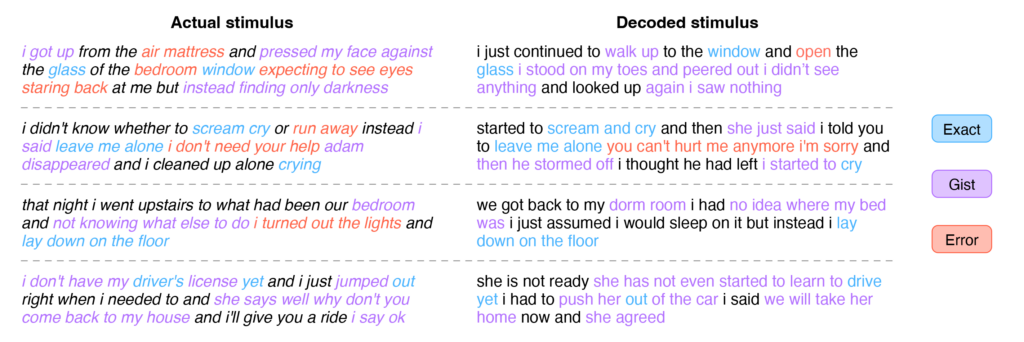Do you think in words or images? Luckly for you – or not – mind-reading AI can now read your thoughts without invasive methods. Really. They can take the brainwaves or brain signals as input or prompt, and generate an output that is the string of text or an image of you’re thinking about. This groundbreaking development reminiscent of a sci-fi movie, was made at the University of Texas at Austin, in which a non-invasive “language decoder” reads brainwaves in real-time. This significant leap in human-AI interaction poses both promising possibilities and concerning questions about privacy. Let’s delve into the implications and explore what the future might hold.
Impact Of Semantic Language Decoder Mind-Reading AI
The recent paper in Nature Neuroscience reveals the creation of a “language decoder” capable of translating human thought into text and images. This revolutionary technology raises questions about the ethical use of such capabilities and how it might reshape various aspects of our lives.

1. Empowering Communication for Speech-Impaired Individuals
One positive aspect of mind-reading AI is its potential to enable speech-impaired or paralyzed individuals to communicate using thought alone. This breakthrough could significantly enhance the quality of life for those facing communication challenges.
2. Aiding Criminal Investigations
The technology also holds promise for aiding criminal investigations. The ability to decode brainwaves could potentially assist in extracting information from individuals unable to communicate through conventional means.
3. Privacy Concerns and the Threat to Personal Freedoms
However, as with any technological advancement, there is a darker side to mind-reading AI. The ability to access and interpret private thoughts in real-time raises profound concerns about privacy. With the integration of this technology into social media and surveillance systems, our thoughts may become vulnerable to external scrutiny.
Visual Hacking: A Potential Ethical Dilemma
Meta, the social media conglomerate, has made strides in decoding brain activity related to visual perception. Using magnetoencephalography (MEG), Meta can visualize what a person is looking at based on their brain activity. While this technological feat seems impressive, it opens the door to ethical dilemmas.

1. Impact on Consumer Behavior
Once integrated into social media algorithms, AI’s ability to “see” what individuals are looking at could lead to hyper-personalized content suggestions. This has the potential to significantly impact consumer behavior, influencing impulsive purchases based on individual interests.
2. The Rise of ‘Visual Hacking’
The term ‘visual hacking’ takes on new dimensions as AI gains the ability to decipher visual processes in real-time. The potential for AI to influence spending behaviors through precisely targeted content raises concerns about the manipulation of consumer choices.
AI-Enhanced Surveillance: Shaping Human Behavior
Surveillance has always influenced human behavior, and AI-powered mind reading takes this impact to unprecedented levels. People alter their behavior when aware of being watched, as demonstrated by the decline in certain online searches following revelations about NSA surveillance.
1. Self-Censorship and Altered Behavior
The knowledge that one’s most private thoughts could be accessed may lead to increased self-censorship and a fundamental shift in behavior. The fear of surveillance could permeate every aspect of personal freedom and expression.
Charting the Path Forward: Balancing Innovation and Ethics
As we stand at this critical juncture in our co-evolution with technology, it is essential to actively engage in shaping the ethical landscape surrounding AI advancements. Balancing innovation with the preservation of fundamental rights and freedoms requires collective effort and the establishment of new regulations.
1. Shaping Regulations for Social Media
To address the potential negative impacts of mind-reading AI on consumer behavior, it is crucial to develop regulations that safeguard user privacy and prevent the manipulation of personal choices through hyper-personalized content.
2. Ensuring User Consent and Personalization
As AI continues to advance, providing users with the option to consent to AI-assisted mind reading or opt out is imperative. Striking a balance between personalization and privacy is key to ensuring that users are not sidelined in a world increasingly dominated by tailored digital interactions.
3. Nurturing Ethical Evolution Alongside AI
The integration of mind-reading AI into our lives necessitates an ongoing ethical evolution. Staying informed about advancements, actively participating in discussions about regulations, and nurturing our collective willpower are essential steps in ensuring that AI enhances, rather than compromises, our shared values.
Conclusion: A Co-Evolutionary Journey
The advent of mind-reading AI signals a profound shift in the dynamics of human-AI interaction. While the technology holds immense potential for positive impact, the ethical considerations surrounding privacy and personal freedom cannot be ignored. As we navigate this co-evolutionary journey, staying vigilant and actively participating in the ethical discourse will be key to shaping a future where AI complements and elevates our human experience.
References
Semantic reconstruction of continuous language from non-invasive brain recordings
Brain decoding: toward real-time reconstruction of visual perception





